
Hydrangea common names hydrangea or hortensia, is a genus of 70–75 species of flowering plants native to Asia and the Americas. By far the greatest species diversity is in eastern Asia, notably Korea, China, and Japan. Most are shrubs 1 to 3 meters tall, but some are small trees, and others lianas reaching up to 30 m (98 ft) by climbing up trees. They can be either deciduous or evergreen, though the widely cultivated temperate species are all deciduous.
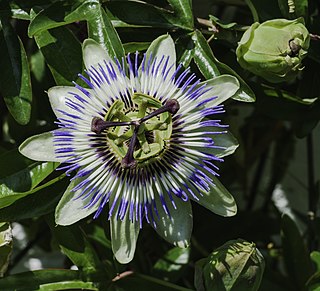
Passiflora caerulea, the blue passionflower, bluecrown passionflower or common passion flower, is a species of flowering plant native to South America. It has been introduced elsewhere. It is a vigorous, deciduous or semi-evergreen tendril vine growing to 10 m (33 ft) or more. Its leaves are palmate and fragrant, flowers blue-white with a prominent fringe of coronal filaments in bands of blue, white, and brown. The ovoid orange fruit, growing to 6 cm (2 in), is edible but bland.

Philadelphus lewisii —also known as Gordon's mockorange, Indian arrowwood, wild mockorange and syringa—a name that usually refers to the unrelated lilacs.—is a deciduous shrub native to western North America, from northwestern California in the Sierra Nevada, north to southern British Columbia, and east to Idaho and Montana. It was first collected by scientist and explorer Meriwether Lewis in 1806 during the Lewis and Clark expedition and the Philadelphus lewisii is named after him.
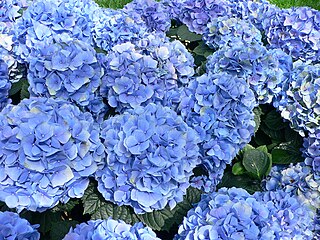
Hydrangea macrophylla is a species of flowering plant in the family Hydrangeaceae, native to Japan. It is a deciduous shrub growing to 2 m (7 ft) tall by 2.5 m (8 ft) broad with large heads of pink or blue flowers in summer and autumn. Common names include bigleaf hydrangea, French hydrangea, lacecap hydrangea, mophead hydrangea, penny mac and hortensia. It is widely cultivated in many parts of the world in many climates. It is not to be confused with H. aspera 'Macrophylla'.

Aquilegia coerulea is a species of flowering plant in the buttercup family Ranunculaceae, native to the Rocky Mountains from Montana south to New Mexico and west to Idaho and Arizona. Its common name is Colorado blue columbine; sometimes it is called "Rocky Mountain columbine," but this also refers to Aquilegia saximontana.
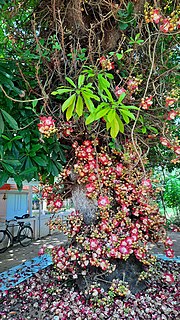
Couroupita guianensis, known by a variety of common names including cannonball tree, is a deciduous tree in the flowering plant family Lecythidaceae. It is native to the tropical forests of Central and South America, and it is cultivated in many other tropical areas throughout the world because of its beautiful, fragrant flowers and large, interesting fruits. Fruits are brownish grey. There are medicinal uses for many parts of Couroupita guianensis, and the tree has cultural and religious significance in India.

Sambucus nigra is a species complex of flowering plants in the family Adoxaceae native to most of Europe and North America. Common names include elder, elderberry, black elder, European elder, European elderberry, and European black elderberry. It grows in a variety of conditions including both wet and dry fertile soils, primarily in sunny locations. The plant is a very common feature of hedgerows and scrubland in Britain and northern Europe, but is also widely grown as an ornamental shrub or small tree. Both the flowers and the berries have a long tradition of culinary use, primarily for cordial and wine. The Latin specific epithet nigra means "black", and refers to the deeply dark colour of the berries.

Brodiaea elegans is a species of flowering plant in the cluster-lily genus known by the common names harvest brodiaea, elegant brodiaea, and elegant cluster-lily.
Brodiaea insignis is a rare species of flowering plant in the cluster-lily genus known by the common name Kaweah brodiaea. It is endemic to the Sierra Nevada foothills of central Tulare County, California, where it grows along the Tule and Kaweah Rivers. It is considered endangered on the state level.
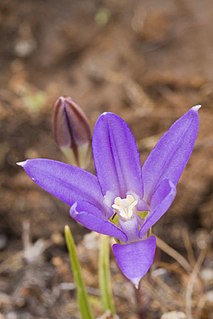
Brodiaea jolonensis, known by the common name chaparral brodiaea, is a species of flowering plant in the cluster-lily family.
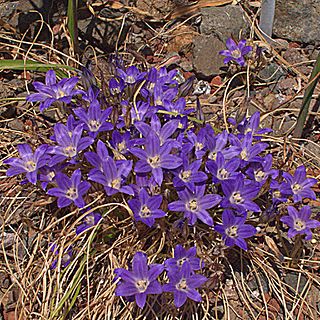
Brodiaea minor is a species of flowering plant in the cluster-lily genus known by the common names dwarf brodiaea and vernalpool brodiaea.
Brodiaea stellaris is a species of flowering plant in the cluster-lily genus known by the common name starflower brodiaea.

Hydrangea serrata is a species of flowering plant in the family Hydrangeaceae, native to mountainous regions of Korea and Japan. Common names include mountain hydrangea and tea of heaven. Growing to 1.2 m (4 ft) tall and broad, it is a deciduous shrub with oval leaves and panicles of blue and pink flowers in summer and autumn (fall). It is widely cultivated as an attractive ornamental shrub throughout the world in areas with suitable climate and soil.

Hydrangea hirta, also known as the "nettle-leaved hydrangea", is an species of flowering plant in the family Hydrangeaceae that is native to East Asia. Due to the beauty and sturdiness of the species' flowers it can be found outside of its range being used for horticultural and landscaping purposes, and is found in gardens in countries including the United Kingdom and the United States.

Hydrangea stylosa is a species of flowering plant in the family Hydrangeaceae, native to China.

Deinanthe is a genus consisting of a few species of rare herbaceous-habit rhizomatous plants found in the mountain woodlands of East Asia, ranging from China to Japan. They are handsome clump-forming perennials good for shade, woodland and rock gardens. These attractive deciduous plants have relatively large "fishtail" leaves. Deinanthes grow at a slow rate to be bushy and shrub-like, 2 ft tall and wide. The leaves attain 3 to 4 inches in length, being deep green, roughly textured, deep veined, cordate at their bases and with serrate margins. The shoots emerge from stout, knobby rhizomes. Leaves are easily damaged in direct sun exposure. Flowering occurs in late summer to early fall. The delicate, waxy, nodding cup-shaped flowers in rich to pale purple-blue, rose or white, are borne in loose terminal clusters. Resembling gargantuan fertile hydrangea flowers, with numerous yellowish to pale blue anthers, they are occasionally accompanied by sterile flowers, as in the lacecap hydrangeas. Roots and leaves are edible.

Senna didymobotrya is a species of flowering plant in the legume family known by the common names African senna, popcorn senna, candelabra tree, and peanut butter cassia. It is native to Africa, where it can be found across the continent in several types of habitat.

Phyllodoce caerulea, known as blue heath in British English and purple mountain heather or blue mountainheath in American English, is an evergreen species of dwarf shrub that grows up to around 15 cm (6 in) tall, and bears clusters of 2–6 purple flowers. It is native to boreal regions around the Northern Hemisphere, but with large gaps in its distribution.
Larsenianthus assamensis is a species of the genus Larsenianthus in the ginger family (Zingiberaceae). It was first described in 2010 and is native to northeastern India.
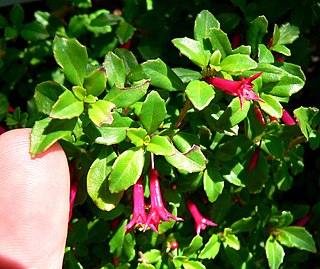
Fuchsia microphylla, also known as small leaf fuchsia and small-leaved fuchsia, is a flowering shrub in the family Onagraceae. The specific epithet (microphylla) was named for the plant's small (micro) leaves (phylla).
















